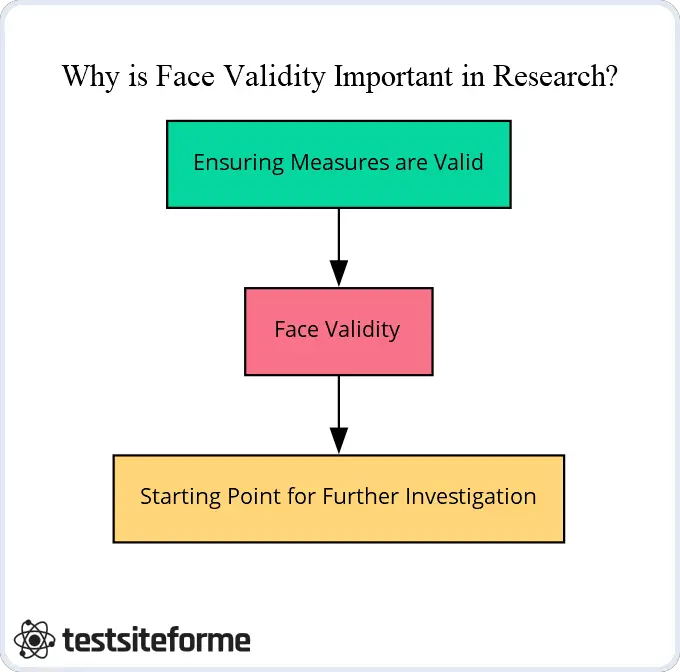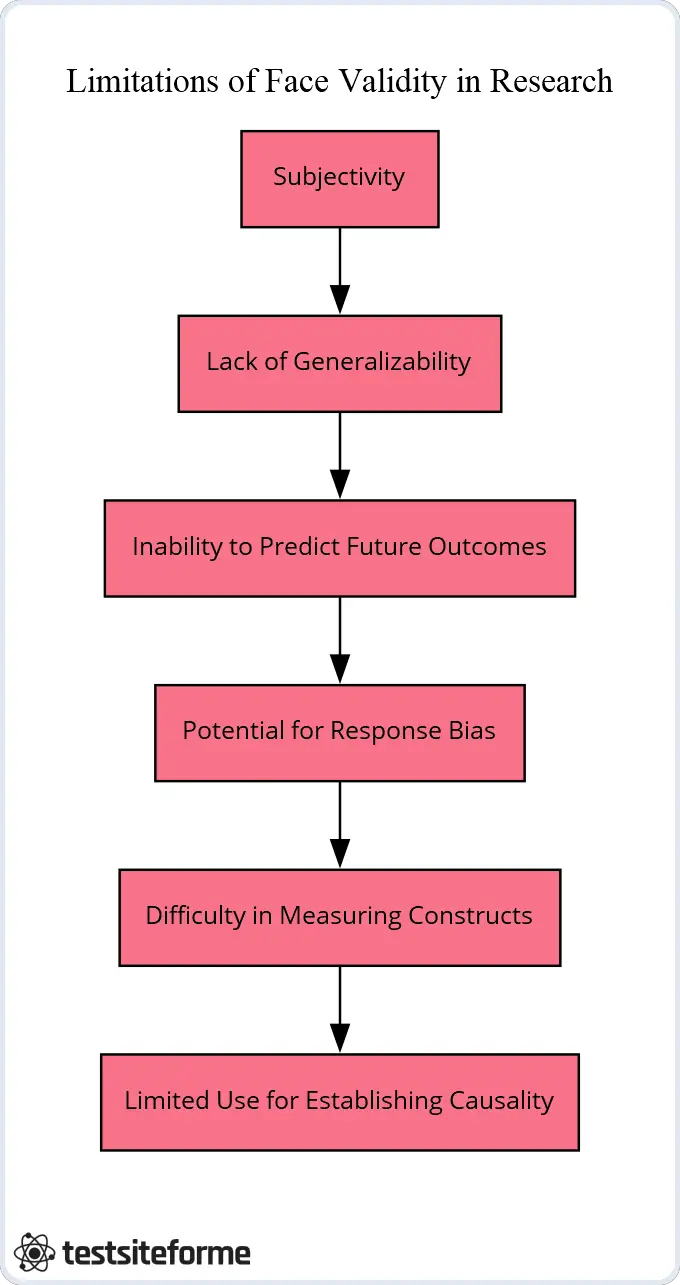Let’s delve into the domain of research and explore an essential aspect – face validity. For those unfamiliar with this concept, fear not as we shall unravel its meaning together in this article.
Face validity is a critical component in research that is often overlooked, but it plays a vital role in ensuring that our measures accurately reflect the concepts we intend to measure. In other words, it refers to how well our measurements appear to measure what they are supposed to measure.
Now you may be wondering what sets face validity apart from other types of validity? Stay tuned as we will discuss this further along with highlighting its importance in research.
Assessing face validity can be tricky; however, fret not as we will walk you through various methods and real-world examples to help clarify any ambiguity surrounding it. Furthermore, we will touch upon limitations and common misconceptions associated with face validity while providing suggestions on how to improve it.
So buckle up and enjoy the ride as we embark on a journey towards understanding the significance of face validity in research!
The Meaning of Face Validity in Research
When conducting research, it’s important to ensure that your measures have good face validity. But what does this term mean exactly? Essentially, face validity refers to how well a measure appears on the surface to be measuring what it claims to be measuring. In other words, if you ask someone about the face validity of a measure, they would likely answer with something like “yes, that seems like an appropriate way to measure that construct”.
It’s important to note that having high face validity doesn’t necessarily mean that a measure is actually valid in terms of its ability to accurately capture and represent the construct being measured. However, it can still be useful as an initial step in evaluating whether or not a measurement tool is worth further investigation.
While there are many different types of validity in research (such as content validity and criterion-related validity), face validity stands out because it is based solely on subjective judgments rather than statistical analysis or objective criteria. This means that while good face validity can certainly indicate strong measurement tools, it shouldn’t be relied upon as the sole determinant of whether or not a measurement tool should be used.
So why do we care so much about having measures with strong face validity? One reason is simply practical – if people don’t believe that your measures are relevant or accurate for capturing what you’re trying to study, they may not participate fully in your research project (or at all!). Additionally, ensuring high levels of face validity can help increase credibility and trustworthiness both within academia and beyond.
If you’re looking for ways to assess whether or not your measures have good face-validity, there are several techniques you can use. For example:
- Ask experts in the field (e.g., other researchers) for their opinions on whether or not your measures appear effective.
- Conduct pilot tests with small groups of participants before launching larger studies.
- Use focus groups or interviews with potential participants to gather feedback on how well they understand and relate to each item/question/etc.
Of course, even when striving for high levels of Face Validity, there will always be some limitations inherent within this type of assessment method. For instance:
- When relying only on subjective judgments from individuals who may have biases/limited experiences
- The possibility exists where certain subgroups might find items more confusing/difficult/stressful than others
Despite these challenges though improving Face Validity remains essential since doing so increases participant buy-in; which ultimately leads towards more representative data collection processes thereby strengthening overall findings quality over time!
The Difference Between Face Validity and Other Types of Validity
When it comes to research, validity is a crucial aspect that cannot be overlooked. Validity refers to the extent to which a research study measures what it intends to measure. Researchers use various forms of validity such as content validity, criterion-related validity, construct validity and face validity.
Face validity is just one form of validity that researchers use in their studies. While all types of validity are important, they differ in terms of criteria and logical underpinnings.
For instance, while face validity focuses on how well a test appears on its surface level or face value in terms of measuring what it claims to measure, other types of validity such as content or construct focus more on the substance or underlying characteristics being measured.
Another difference between face validity and other types relates to how they are established. Content and construct validation require statistical analyses whereas for Face Validation relies heavily on expert judgement alone.
It’s essential for researchers not only understand the different types of validities, but also how each type can be applied within their specific field or domain. By doing so, you can ensure that their data accurately reflects reality and enhances our understanding of different phenomena.
In short – different forms of validity exist, each with distinct criteria regarding what counts as valid data collection methods. Face Validation is just one form among many others used by researchers when deciding whether something is worthy enough to be considered legitimate evidence towards answering particular research questions!
Why is Face Validity Important in Research?
When it comes to research, ensuring that your measures are valid is crucial. Face validity serves as an initial check to ensure that the study’s measures appear on their face to measure what they claim to be measuring. While this type of validity is not sufficient on its own, it does provide a starting point for further investigation.
One reason why face validity is important in research is to ensure informed consent from potential participants. If a measure appears irrelevant or unrelated to the study’s stated purpose, participants may be hesitant or unwilling to participate. This can lead to biased samples and affect the generalizability of the results.
Another reason why face validity matters in research is because it provides an opportunity for statistical analyses early on in the process. Researchers can use preliminary data gathered through their measures with high face validity as a starting point for more complex analyses later on.
Assessing face validity can involve several methods, including expert review and pilot testing with a sample population. Through these processes, researchers can determine if there is a reasonable degree of agreement between what they claim their measure assesses and how others interpret it.

For example, imagine you are designing a survey about people’s attitudes towards climate change. You might ask colleagues who work in environmental policy or advocacy organizations whether they think your questions accurately capture public opinions about climate change issues.
While ensuring high levels of face validity may seem straightforward enough at first glance, there are some limitations that researchers should keep in mind when using this method alone.
- For one thing, relying solely on surface-level appearances might miss subtle underlying factors impacting responses.
- Additionally, people may respond differently based merely upon how questions are phrased rather than the actual content being measured.
Therefore researchers must take care not only when assessing but also interpreting results derived from self-report surveys designed using primarily facially valid items.
To improve upon low levels of perceived face-validity among respondents:
- Consider conducting pretests and pilot tests before administering questionnaires
- Solicit feedback from experts within relevant fields
- Ensure instructions accompanying questionnaires clarify goals behind each item
While having high levels of “face-validity” doesn’t guarantee accuracy by itself due to various confounding factors influencing participant response behavior; nevertheless ensuring questionnaire items appear superficially related helps bolster participant engagement which could affect overall response rates positively – making sure such “appearance” doesn’t compromise scientific rigor requires additional steps beyond just relying solely upon facial appearance!
Face validity is crucial for ensuring that your research measures what it claims to measure. To increase the face validity of your study, consider involving stakeholders or experts in the field to review and give feedback on your research design and instruments. This can help you identify potential issues and ensure that your study produces meaningful and valid results.
How to Assess Face Validity in Your Research Measures
When conducting research, its essential to ensure that your measures are valid. The measure of validity refers to the extent to which a measurement accurately reflects what it is intended to measure. One type of validity is face validity, which assesses whether a measurement appears on its face to be measuring what it claims to be measuring.
To assess face validity in your research measures, you can use several methods. One common method is asking experts in the field their opinion on whether the measurements appear appropriate and relevant. Another approach involves having participants review and provide feedback on the measurements’ clarity and relevance.
It’s important not to confuse face validity with other types of measurement validity like criterion-related or construct-related measures. While criterion-related measures focus on how well one measure predicts another measure (criterion), construct-related measures assess how well a tool reflects an underlying concept or theory.
However, even though face validity may seem less rigorous than other types of validation techniques, it remains essential in ensuring that outcome measures make sense for researchers and participants alike. Face-valid instruments foster trust by aligning study goals with participant expectations and reducing confusion.
For instance, if you’re designing an assessment test for teachers evaluating students’ reading abilities, you might ask teachers if they think your exam items are representative of typical reading tasks at different grade levels. Or have parents review survey questions about their child’s health behaviors before administering them as part of a larger study.
One limitation of using only face-valid approaches as evidence for the accuracy of outcome tools would be relying solely on subjective perceptions without objective data collection procedures resulting from empirical testing or statistical analyses verifying cause-effect relationships between variables measured by different scales within one experiment context.
But don’t let this undermine its importance; sometimes testing more complex powers can lead researchers down rabbit holes that ultimately lead nowhere useful when simpler methods would suffice just fine!
In short, it’s fair to say that assessing face-validity helps researchers evaluate whether their outcome-measures look good enough “on paper” so they don’t waste valuable time pursuing dead-end theories based only upon gut feelings rather than hard data – making sure your results will hold up under scrutiny!
Assessing Face Validity in Research Measures
This table outlines common methods for assessing face validity in research measures, including expert review, pilot testing, and user feedback.
| Method | Description |
|---|---|
| Expert Review | A panel of experts in the field reviews the measure and provides feedback on its face validity. |
| Pilot Testing | Administering the measure to a small sample of participants to identify any unclear or confusing items. |
| User Feedback | Gathering feedback from participants on the measure’s clarity and relevance to the concept being measured. |
Real-World Examples of Face Validity in Research
Real-world examples of face validity in research can be found across a variety of fields. One such example is the use of surveys to gather data, where questions are designed to appear relevant to respondents and therefore likely to elicit honest answers. This approach has been used in many studies, including those investigating public attitudes towards controversial issues such as abortion or immigration.
Another example is the use of personality tests in psychology, which often rely heavily on face validity. These tests may ask participants about their preferences for certain activities or behaviors, with the assumption that these responses will give insight into their underlying personality traits.
However, it’s important to note that face validity should not be confused with other types of validity such as concurrent or discriminant validity. While face validity refers specifically to how well a measure appears at face value, these other forms of validity assess whether a measure correlates with other measures (concurrent) or distinguishes between different groups (discriminant).
One potential drawback of relying solely on face valid measures is that they may not always accurately reflect what they claim to measure – known as ethological invalidity. For instance, asking students about their study habits might seem like an effective way to gauge academic performance but could prove inaccurate if students exaggerate their studying efforts.
Therefore, researchers must carefully evaluate all aspects of their measures before drawing conclusions based solely on apparent relevance (face validation) alone. This includes checking for reliability over time and across different samples by comparing results from test scores taken at different points in time (test-retest reliability) or from multiple groups (inter-rater reliability).
In view of all this, while there are many real-world examples where face-valid measurements have proven useful in research contexts; this approach has its limitations too – particularly when it comes down to measuring complex constructs like human behavior and attitudes towards sensitive topics like politics and religion. Researchers need a nuanced understanding of both what makes measures appear valid (‘at face value’) and how well they perform under various conditions for optimal results – taking into account both face-validity concerns alongside more rigorous methods assessing things like reliability over time/samples etc., so that we can make informed decisions based upon our findings rather than being swayed by subjective impressions alone!
When assessing the face validity of a research study, put yourself in the shoes of those who will be affected by the results. Consider whether the study’s methods and measures align with their expectations and experiences, and whether it captures all relevant aspects of the topic at hand. By prioritizing face validity, you can ensure that your research is not only rigorous but also meaningful and actionable for those who need it most.
The Limitations of Face Validity in Research
When it comes to research, face validity is a term that refers to the extent to which an assessment or measure appears on the surface to accurately assess what it’s intended to measure. However, there are limitations when using face validity alone as a measure of accuracy in research.

One limitation is that face validity doesn’t necessarily equate with mechanistic validity. That means just because something looks like it should work, doesn’t mean it actually does. For example, just because a study claims that drinking coffee can increase productivity at work doesn’t mean coffee is actually responsible for the increased productivity – there could be other factors at play.
Another limitation of relying solely on face validity is that it may not account for all types of potential sources of error and bias in data collection and analysis. While face validity does provide some assurance about external appearance and initial impressions, researchers need to also consider more rigorous measures such as internal consistency or internal validity when assessing psychometric properties.
Internal consistency refers to how well different items within an assessment relate to each other; if they don’t correlate well together then this suggests problems with the overall reliability of the assessment. Internal consistency checks allow researchers greater confidence in their findings by ensuring that variables are reliably measured across multiple questions or measures.
In contrast, internal validity focuses more specifically on whether observed effects can be attributed directly back to specific causal factors rather than any extraneous variables which might have influenced them otherwise (such as participant selection bias). This type of validation helps ensure results are robust enough for generalization beyond sample populations.
To overcome these limitations, researchers must use multiple types of validation techniques beyond just face value assessments. One way this can be done is through triangulation – where two or more methods are used simultaneously so they complement each other’s strengths and weaknesses rather than relying solely on one method like Face Validity.
Ultimately Face Validity has its place within scientific inquiry but shouldn’t be relied upon exclusively without additional corroboration from complementary approaches such as triangulation.
Examples:
- A survey asking students if they feel anxious before exams would likely have high face value since anxiety before exams seems reasonable.
- However, testing participants’ saliva levels for cortisol (a hormone-related stress) would provide mechanistic evidence supporting/explaining why some people experience higher anxiety during times when tests loom large.
While useful in certain situations – particularly where pragmatic concerns require quick assessments – reliance purely on Face Validity risks limiting our understanding by potentially overlooking important nuances relevant only via a deeper investigation into underlying mechanisms driving those phenomena under scrutiny.
While face validity can be a useful tool in research, it is important to recognize its limitations. Always consider other forms of validity, such as construct or content validity, and ensure that your research design aligns with your overall goals and objectives. By taking a comprehensive approach to validity, you can strengthen the credibility and impact of your research findings.
How to Improve Face Validity in Your Research Measures
Improving the face validity of your research measures is essential to ensure that the data collected is a valid measure of what you are trying to study. To achieve this, it’s important to consider several factors in your research methods and measurement procedure.
- Firstly, when designing your study, you should ensure that the research design aligns with the aim of the study. For example, if you are studying customer satisfaction in a restaurant setting, then it would be appropriate to use a survey questionnaire or interview questions that focus on aspects such as food quality and service delivery.
- Secondly, it’s crucial to select participants who are representative of your target population. If not done correctly, this can lead to biased results which can limit face validity. A useful tip is using random sampling techniques since they help avoid bias and provide more accurate representations.
- Thirdly, create clear instructions for participants about what they need to do during their participation in the study. This will ensure consistency across different groups of people taking part in different stages and also helps reduce errors caused by a lack of understanding.
- Fourthly, pilot test all surveys or interviews before sending them out widely. Piloting provides an opportunity for feedback from respondents thereby promoting a better understanding of researchers’ intentions and data collection processes.
- Fifthly, use qualitative methods like interviews alongside quantitative ones like surveys since these have been proven effective at capturing non-measurable constructs like emotions or attitudes.
Improving face validity requires careful consideration throughout each step: from designing studies to selecting participants to collecting data (from questionnaires). All these steps combined promote better alignment between researcher intentions with actual measurement procedures leading towards more reliable outcomes which ultimately generates valuable insights into whatever topic one chooses!
As Maya Angelou once said – “Do the best until you know better; then when you know better do even better”.
Strategies for Improving Face Validity
This table outlines strategies for improving face validity in research measures. Use it to enhance the face validity of your research and ensure accurate results.
| Strategy | Description |
|---|---|
| Involving Experts | Consult with subject matter experts to ensure that your measures are relevant and appropriate. |
| Pilot Testing | Test your measures on a small sample before using them in your study to identify potential issues. |
| Multiple Sources of Data | Use a variety of data sources, such as self-report and observation, to provide a more complete understanding of the concept being measured. |
Common Misconceptions About Face Validity
Many people believe that if a research measure has “poor face validity,” it must not be a valid measure. However, this is not necessarily true. As the saying goes, don’t judge a book by its cover – just because something appears to be irrelevant or unimportant on the surface does not mean it lacks value.
In fact, some measures may have low face validity but still provide accurate and reliable results when tested against other criteria. For example, an existing test for racial prejudice may seem unrelated to measuring racism at first glance, but through rigorous testing and validation procedures, researchers can determine its effectiveness in accurately measuring levels of prejudice.
On the other hand, poorly designed measures with high face validity can also lead to inaccurate results. A questionnaire that asks direct questions about an individual’s political beliefs may appear relevant on the surface but could potentially suffer from social desirability bias or lack of objectivity.
It is important to keep in mind that while face validity can serve as a useful initial indicator of whether a research measure seems appropriate for its intended purpose or population group, it should not be relied upon as the sole determinant of whether a measure is valid or reliable.
To avoid falling into common misconceptions about face validity in research:
- Understand that low face validity does not necessarily equate to poor quality.
- Consider multiple sources of evidence when evaluating your measures’ effectiveness.
- Keep your research goals and target populations in mind when selecting appropriate measurement tools.
Ultimately, what matters most is ensuring that our methods are scientifically sound and grounded in established principles so we can confidently draw conclusions from our findings.
The Relationship Between Face Validity and Reliability
When conducting research, there are various types of validity and reliability that researchers must consider. While face validity is important, it’s not the only type of validity that matters. Other types include criterion validity, predictive validity, and construct validity.
One crucial aspect of research is reliability, which refers to the consistency and stability of a measure over time. Test-retest reliability measures how well a test produces consistent results when administered multiple times over a period.
Now you may be wondering: what’s the relationship between test-retest reliability and face validity? Well, while they’re both essential components of good research design, they don’t necessarily go hand in hand. A measure can have high face validity but low test-retest reliability or vice versa.
For example, imagine you’re designing a questionnaire to assess stress levels in college students during final exams week. You might ask questions like “Do you feel overwhelmed by your workload?” This question has high face validity because it appears to be relevant to measuring stress levels during final exams week; however, its usefulness may depend on other factors like age or gender differences amongst respondents.
On the other hand, an assessment with high test-retest reliability will produce consistent results across different administrations regardless of external factors such as time or location.
It’s also worth noting that having high face-validity does not guarantee accuracy or effectiveness in measuring what it intends to measure – this is where other types of validities come into play such as criterion and construct validities.
To put it briefly, face-validity plays an important role in research but is just one component among many others such as criterion or construct validities. It doesn’t necessarily predict whether a measure will produce accurate/consistent results. Incorporating multiple forms of validation can help ensure more comprehensive assessments.
However, researchers should prioritize establishing high-test re-test reliabilities since even if their findings are significant, it will be difficult for them to replicate those findings if their measurements aren’t reliable enough. This highlights the importance of researchers seeking ways to improve their measures beyond just focusing on getting them right from outward appearance alone.
Conclusion: The Significance of Face Validity in Research
As a result of all this, understanding the significance of face validity in research is crucial to ensure that the measures you use are effective in measuring what they claim to measure. While it may not be as robust as other types of validity such as content validity, external validity, and the conception of construct validity, it still plays an essential role in research.
Face validity can help increase participant engagement and buy-in, which ultimately leads to more accurate data collection. By assessing face validity through pilot studies or expert reviews, researchers can identify potential issues with their measures before collecting large amounts of data.
However, it’s important to note that face validity has its limitations. For example, just because a measure appears valid on its face doesn’t mean that it truly is valid. Additionally, relying solely on face validity can lead to over-reliance on subjective judgments rather than objective criteria.
To improve face validity in your research measures, consider incorporating feedback from experts or participants themselves. This can help identify any areas where the measure may need improvement and ultimately increase its effectiveness.
It’s also essential to recognize common misconceptions about face validity – for example, some researchers mistakenly believe that high face-validity automatically implies high construct or convergent/ discriminant validities – this is not always true! Instead, look at how these different concepts relate together within your research design.
Finally, you should keep in mind the relationship between face validity and reliability- while both are important aspects of good measurement practices, the former focuses more on surface-level appearance whilst the latter is concerned with consistent results across time, researchers must weigh up whether higher levels of one come at a cost for another!
With all this in mind, face validity isn’t perfect but is a useful way for researchers to assess if their measures seem appropriate; you shouldn’t rely entirely upon it though! Incorporate feedback from experts or participants when designing your research instruments, and recognise how each concept interrelates (i.e., content-, external-, construct-, convergent- & discriminant-validities) so you’re using them appropriately together!







